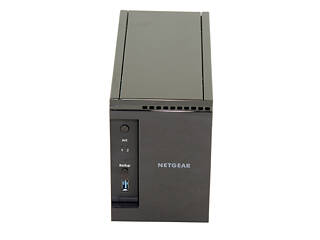 3
3
Netgear ReadyNAS 202 Review
Specifications »Introduction

We would like to thank Netgear for supplying the review sample.

This is the first time we get to evaluate a Netgear NAS, and the main subject of today's review will be a member of the fresh ReadyNAS 200 line. Both the ReadyNAS 202 and 204 use a dual-core ARM Cortex A15 CPU clocked at 1.4 GHz, and not only do both come with an unusually high amount of RAM for a home NAS, but two Gigabit Ethernet ports for either more reliability or faster network transfer speeds, which depends on their mode of operation. That said, the ReadyNAS 202's most important feature isn't its hardware, but its file system. Contrary to most NAS servers that use EXT4, Net-gear's offering uses Btrfs, or B-tree.
Before we start covering the advantages of Btrfs, we had better take a look at what a file system actually does. A file system essentially controls how data is stored and retrieved. It, in other words, provides a way to separate and identify chunks of data. All information inside a storage area is a large body of data without a file system, which would make finding and retrieving a specific piece of data impossible. There are many different file systems today, each with its own advantages that are due to its logic of operation. File systems use metadata, data whose purpose it is to describe some crucial features of specific pieces of data, like creation date, modification date, file size, etc., to properly store and retrieve files.
The ext4 journaling file system is currently the most popular for Linux distributions; however, during the past years, some other file systems with more capabilities an end-user can tap into have emerged. One of these is Btrfs, a copy-on-write filesystem, "COW" for short, with support for a maximum file size of 16 EiB instead of the 1 EiB in ext4. Btrfs also includes other features like snapshots, pooling, and checksums. One of the key features of Btrfs is snapshot, a special type of subvolume that doesn't make copies of files but shares the data and metadata of the subvolume, which makes it very fast and takes very little space. In Btrfs, subvolumes don't have fixed sizes. Their space is dynamically allocated from the storage pool according to the data that is added or removed. Subvolume creation is also pretty easy, and a subvolume can even have nested subvolumes. There is by default always a top-level subvolume, and it is mounted with all of its own subvolumes, but you can change the default subvolume to allow for a specific subvolume to be mounted without having to mount the subvolume that contains it.
May 5th, 2024 08:14 EDT
change timezone
Latest GPU Drivers
New Forum Posts
- Resolution problems in-game with Av receiver (windows 11) (2)
- Display Screen buying inputs. (5)
- RX 6800 causing stuttering when typing text (Low 2D/IDLE Clocks?) (27)
- Browser Bechmark scores (94)
- Only some humans can see refresh rates faster than others, I am one of those humans. (120)
- Arctic MX-6 shelf life is just a couple months? (88)
- Is updating BIOS to beta versions a good idea if you have the most recent version installed but still face issues? (7)
- Apparently Valve is giving refunds on Helldivers 2 regardless of hour count. Details inside. (38)
- Unigine Heaven 4.0 Benchmark Scores Part 2 (931)
- AI Benchmark Alpha version 0.1.2 (2)
Popular Reviews
- Finalmouse UltralightX Review
- Meze Audio LIRIC 2nd Generation Closed-Back Headphones Review
- ASRock NUC BOX-155H (Intel Core Ultra 7 155H) Review
- Montech Sky Two GX Review
- Cougar Hotrod Royal Gaming Chair Review
- Upcoming Hardware Launches 2023 (Updated Feb 2024)
- Alienware Pro Wireless Gaming Keyboard Review
- AMD Ryzen 7 7800X3D Review - The Best Gaming CPU
- HYTE THICC Q60 240 mm AIO Review
- Logitech G Pro X Superlight 2 Review - Updated with 4000 Hz Tested
Controversial News Posts
- Intel Statement on Stability Issues: "Motherboard Makers to Blame" (240)
- Windows 11 Now Officially Adware as Microsoft Embeds Ads in the Start Menu (167)
- AMD to Redesign Ray Tracing Hardware on RDNA 4 (142)
- Sony PlayStation 5 Pro Specifications Confirmed, Console Arrives Before Holidays (117)
- AMD's RDNA 4 GPUs Could Stick with 18 Gbps GDDR6 Memory (114)
- NVIDIA Points Intel Raptor Lake CPU Users to Get Help from Intel Amid System Instability Issues (106)
- AMD Ryzen 9 7900X3D Now at a Mouth-watering $329 (104)
- AMD "Strix Halo" Zen 5 Mobile Processor Pictured: Chiplet-based, Uses 256-bit LPDDR5X (103)
